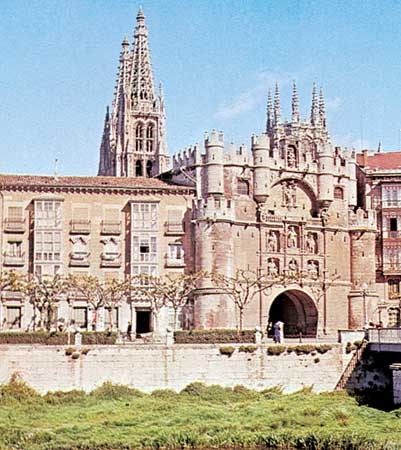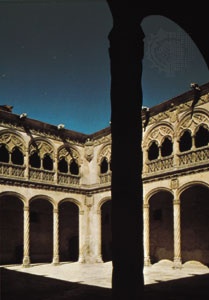Castile-León
region, Spain
Spanish Castilla y León
 comunidad autónoma (autonomous community) and historic region of northwestern Spain, encompassing the provincias (provinces) of Valladolid, Burgos, León, Salamanca, Zamora, Palencia, Ávila, Soria, and Segovia. Its capital is the city of Valladolid. Castile-León is bounded by the autonomous communities of Asturias, Cantabria, and the Basque Country to the north; La Rioja and Aragon to the east; Castile–La Mancha, Madrid, and Extremadura to the south; and Galicia to the northwest. Portugal lies to the west. The autonomous community of Castile-León was established on Feb. 25, 1983, from the historic region of Old Castile. The capital is Valladolid. Area 36,221 square miles (93,813 square km). Pop. (2007 est.) 2,528,417.
comunidad autónoma (autonomous community) and historic region of northwestern Spain, encompassing the provincias (provinces) of Valladolid, Burgos, León, Salamanca, Zamora, Palencia, Ávila, Soria, and Segovia. Its capital is the city of Valladolid. Castile-León is bounded by the autonomous communities of Asturias, Cantabria, and the Basque Country to the north; La Rioja and Aragon to the east; Castile–La Mancha, Madrid, and Extremadura to the south; and Galicia to the northwest. Portugal lies to the west. The autonomous community of Castile-León was established on Feb. 25, 1983, from the historic region of Old Castile. The capital is Valladolid. Area 36,221 square miles (93,813 square km). Pop. (2007 est.) 2,528,417.The terrain of Castile-León consists mainly of an undulating plateau with an average elevation of about 2,500 feet (760 metres). This plateau has a natural frontier of mountains on all sides, except along the border with Portugal. The plateau is enclosed on the north by the Cantabrian Mountains, on the east by the Sierra de la Demanda and its offshoots, which are part of the Iberian Cordillera, and on the south by the Sierra de Guadarrama, Sierra de Gredos, and Sierra de Gata. On the northwest the highlands of Ancares, Caurel, and Eje separate the region from Galicia, and on the west the Duero River divides the region from the plain that declines gradually into Portugal. The Cantabrian Mountains in the north are separated from the Iberian Cordillera to the northeast by an important topographic and communication corridor, La Bureba.
The central plateau is actually the northern half of a still-larger interior plateau, the Meseta Central, that occupies almost all of central and northern Spain. Castile-León is drained chiefly by the Duero River, which flows east to west and bisects the region. A continental climate, modified by oceanic influences, prevails, with hot summers and long winters. The annual precipitation is low, ranging from 16 to 24 inches (400 to 600 mm), and is concentrated in the autumn and spring. Precipitation is higher in the mountains, where snow is common.
 Castile-León's population as a percentage of Spain's has declined sharply since 1900. Emigration from the countryside has been especially high, with the result that the population is increasingly concentrated in the towns and especially in the provincial capitals. The chief cities are Valladolid, León, Burgos, Salamanca, and Palencia. Minifundios, or small landholdings, predominate in the countryside and are cultivated by their owners. The Leonese dialect heard in parts of the region derives from the vernacular of the Visigothic period; it is spoken in León, Zamora, Salamanca, and Valladolid provinces. Farmsteads in the mountains are ordinarily multistoried and built of stone and wood, while those in the central plateau are built of adobe. The region's cities and towns are notable for their Romanesque churches, Gothic cathedrals, and medieval castles, which give the region its name—castillo (“castle”).
Castile-León's population as a percentage of Spain's has declined sharply since 1900. Emigration from the countryside has been especially high, with the result that the population is increasingly concentrated in the towns and especially in the provincial capitals. The chief cities are Valladolid, León, Burgos, Salamanca, and Palencia. Minifundios, or small landholdings, predominate in the countryside and are cultivated by their owners. The Leonese dialect heard in parts of the region derives from the vernacular of the Visigothic period; it is spoken in León, Zamora, Salamanca, and Valladolid provinces. Farmsteads in the mountains are ordinarily multistoried and built of stone and wood, while those in the central plateau are built of adobe. The region's cities and towns are notable for their Romanesque churches, Gothic cathedrals, and medieval castles, which give the region its name—castillo (“castle”).The central plateau of Castile-León is endowed with naturally fertile soils, but drought is common because of inadequate rainfall, and in many areas irrigation is needed to produce good crops. Where irrigation is lacking, vast tracts of land are useless except as pasture for sheep, and much of the Castilian landscape is in fact an arid, barren, and windswept steppe, with scarcely a tree or a spring of water. Most of the cultivated land is dry-farmed, and barley is the leading crop. Irrigation is more widespread in the provinces of Valladolid and León, where the crops include sugar beets, potatoes, and beans. Grapes are largely restricted to marginal farmland and are of declining importance. In general, the fragmentation of the region's farmland has hindered the mechanization of agriculture, and a disproportionately high percentage of the workforce continues to be employed in agriculture. Animal husbandry accounts for a large percentage of Castile-León's agricultural output; the leading animals are sheep, pigs, and dairy and beef cattle. Many of the northern mountains are well wooded, and forestry is a major industry in these zones.
The development of manufacturing in the region did not begin until 1945 and remains modest. The National Institute of Industry has fostered the industrialization of Valladolid through long-term loans and tax incentives; that city's manufactures are diversified and include automobiles, fertilizers, foodstuffs, and paper. The industrial development of Burgos was initiated in 1964 and has established the city as another leading industrial centre of the region. The provinces of León, Zamora, and Salamanca produce about one-fourth of Spain's anthracite coal. Dams in the provinces of Salamanca and Zamora generate about one-fourth of Spain's hydroelectricity; most of the electricity generated is exported to the industrial centres of the Basque provinces and Madrid. Services are the dominant economic activity in the provincial capitals and other cities in the region.
- Nanning
- nanotechnology
- Nanping
- Nan River
- Nansen bottle
- Nansen, Fridtjof
- Nansen International Office for Refugees
- Nanshe
- Nantahala River
- Nanterre
- Nantes
- Nantes, Edict of
- Nantes, University of
- Nanteuil, Robert
- Nantgarw porcelain
- Nanthasen, Chao
- Nanticoke
- Nantong
- Nan-t'ou
- Nantucket
- Nantwich
- nanxi
- Nanyang
- Nanzhao
- Naomi Kawase